In the open grasslands, farmlands and suburban parks of Australia, the gentle whirring of wings often gives away the presence of the Crested Pigeon (Ocyphaps lophotes). Once limited mainly to inland areas, this striking pigeon has expanded its range into coastal regions and urban environments, becoming a familiar sight across much of the country. With its elegant crest and distinctive wing sounds, the Crested Pigeon is both beautiful and instantly recognisable.
Identification
The Crested Pigeon is a medium-sized pigeon, around 30-34 cm in length. Its plumage is mostly grey-brown, with pinkish underparts and a small but elegant black crest projecting from the head. The wings are patterned with black bars and patches of iridescent green and purple that catch the sunlight. The most distinctive feature, however, is its flight: specially modified wing feathers produce a high-pitched whistling or “whirring” sound every time it takes off, thought to serve as both a warning to other pigeons and a distraction for predators.
Habitat and Distribution
Ocyphaps lophotes is widespread across most of mainland Australia, absent only from the densest rainforests and driest deserts. It prefers open habitats such as grasslands, farmland, lightly wooded areas and urban parks. Its ability to exploit water sources and modified landscapes has enabled it to expand into regions where it was once uncommon, particularly along the eastern seaboard. Today, it is a common bird in both rural and suburban settings.
Ecological Role
Crested Pigeons are primarily granivores, feeding on seeds from grasses, weeds and cultivated crops. In doing so, they influence plant community dynamics and can play a role in dispersing seeds. Their presence in agricultural areas highlights the adaptability of native birds to human-modified landscapes. They are also an important food source for raptors such as hawks and falcons, fitting neatly into the trophic web of open-country ecosystems.
Behaviour and Reproduction
Crested Pigeons are social, often seen foraging in small groups or larger flocks. They are wary birds, flushing quickly when disturbed, their wing whistle acting as an alarm to companions. Their cooing calls are soft and rhythmic, contrasting with their dramatic take-off sounds.
Breeding can occur year-round in favourable conditions, particularly near water. Pairs build flimsy stick nests in shrubs, trees, or even on man-made structures. Clutches typically contain two white eggs, incubated by both parents. Chicks fledge within about three weeks and pairs may raise multiple broods in a year when food is abundant.
Conservation Status
The Crested Pigeon is listed as Least Concern under both the Biodiversity Conservation Act 2016 (Western Australia)and the Nature Conservation Act 1992 (Queensland). It is one of Australia’s most secure native pigeons, with populations stable or increasing due to their ability to adapt to farmland and urban environments.
Threats
The species faces few major threats, thanks to its adaptability. However, habitat clearing that removes nesting sites, predation by cats and foxes and collision with vehicles or windows in urban areas can impact local populations. In some regions, they may be at risk from secondary poisoning through pest control measures.
Conservation Efforts
As a widespread and secure species, the Crested Pigeon does not require targeted conservation actions. It benefits from the creation of artificial water points in agricultural regions and thrives in open, modified habitats. Public education about reducing cat predation and designing bird-safe windows can help reduce human-related mortality.
Final Thoughts
The Crested Pigeon is a bird that epitomises adaptability – elegant, resilient and increasingly at home in both natural and human-altered landscapes. Its whistling wings are a soundtrack to the Australian countryside and suburbs alike, a reminder that native wildlife can find its place alongside people when habitats remain available. Protecting Ocyphaps lophotes is less about rescue and more about appreciation, ensuring its whirr and flutter continue to accompany daily life across the continent.
Fauna Resources specialises in the safe handling of a range of different fauna species, through safe, effective and ethical fauna solutions. By providing dedicated fauna services, through passionate fauna spotter catchers and fauna specialists, we can support the unique terrestrial ecosystems and rich biodiversity Australia has to offer.
For more information about our specialist fauna services contact Fauna Resources today.
